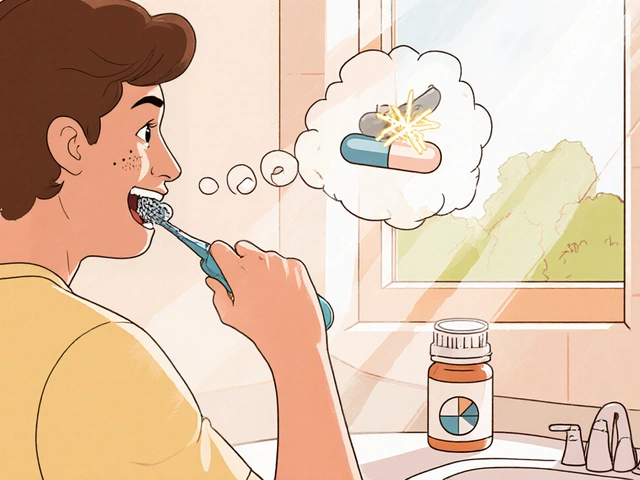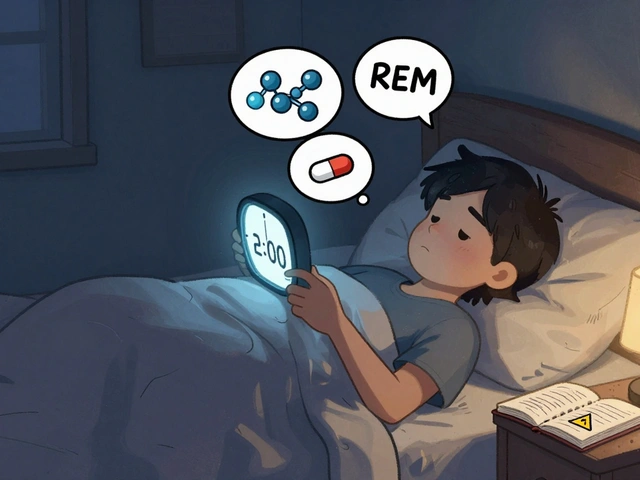Miconazole Treatment Duration Calculator
Based on clinical guidelines from the article, this calculator estimates the appropriate duration of miconazole treatment for different fungal infections. Always complete the full course as prescribed.
Recommended Treatment Duration
2-4 weeksComplete the full course as prescribed. Treatment duration may vary based on individual response and infection type.
Key Takeaways
- Apply miconazole as directed, usually twice daily, for the full course.
- Identify the type of fungus (dermatophytes, Candida, etc.) to choose the right formulation.
- Combine topical treatment with good hygiene for faster clearance.
- Know when to switch from over‑the‑counter to prescription‑strength options.
- Watch for side effects and seek medical help if symptoms persist beyond two weeks.
What Is Miconazole?
When you hear the name Miconazole is an imidazole‑type antifungal medication used to treat a wide range of skin and mucosal fungal infections. It works by inhibiting the synthesis of ergosterol, a key component of fungal cell membranes, which leads to cell leakage and death. First approved in the early 1970s, it is now available as creams, powders, sprays, and vaginal tablets.
Common Fungal Infections Treated with Miconazole
Not all fungal problems are the same. Knowing the culprit helps you pick the right product and treatment length.
- Dermatophytes are the fungi that cause athlete’s foot, jock itch, and ringworm. They thrive in warm, moist environments.
- Candida albicans is the yeast behind yeast infections, oral thrush, and diaper rash.
- Other moulds, such as Malassezia, can cause dandruff or seborrheic dermatitis.
Choosing the Right Miconazole Formulation
Different parts of the body need different delivery methods. Here’s a quick guide:
| Formulation | Typical Use | Strength |
|---|---|---|
| Cream (1%) | Foot, hand, groin, body rash | 1% w/w |
| Powder (2%) | Moist areas, shoe inserts | 2% w/w |
| Spray (2%) | Scalp, large surface areas | 2% w/w |
| Vaginal tablet (200 mg) | Vulvovaginal candidiasis | 200 mg per tablet |
Step‑by‑Step: How to Apply Miconazole Cream Correctly
- Wash the affected area with mild soap and warm water. Pat dry - moisture can dilute the cream.
- Apply a thin layer of the cream to the lesion and a 1‑cm margin of healthy skin.
- Rub gently until the medication disappears. No need to cover unless instructed.
- Repeat twice a day (morning and evening) for the full recommended period, usually 2‑4 weeks.
- For foot infections, sprinkle a thin layer of powder after the cream has been absorbed to keep the area dry.
Consistency beats intensity. Missing doses can let the fungus rebound.
When to Switch to Prescription‑Strength Options
Over‑the‑counter (OTC) Miconazole 1% cream works for most mild‑to‑moderate cases. However, you might need a stronger approach if:
- Symptoms persist beyond 14 days despite proper use.
- The infection is extensive (covering large body areas or multiple sites).
- You have a compromised immune system (e.g., diabetes, HIV).
In those scenarios, doctors often prescribe a higher‑strength cream (2% or 4%) or combine topical therapy with an oral antifungal such as Itraconazole or Terbinafine. The choice depends on the fungus type and patient health.
Comparing Miconazole to Other Common Antifungals
| Antifungal | Mechanism | Typical Strength (Topical) | Best For |
|---|---|---|---|
| Miconazole | Inhibits ergosterol synthesis (imidazole) | 1‑2% cream, 200 mg vaginal tablet | Dermatophytes, Candida, mixed infections |
| Clotrimazole | Similar to imidazoles, blocks sterol production | 1% cream, 1% solution | Localized athlete’s foot, minor yeast infections |
| Terbinafine | Allylamine - inhibits squalene epoxidase | 1% cream, 250 mg oral tablets | Hard-to‑treat dermatophyte infections, onychomycosis |
In practice, miconazole is often the first choice because it covers a broader range of fungi and is widely available OTC.
Tips for Maximizing Treatment Success
- Keep the area dry. Use talc‑free powders after the cream.
- Avoid tight shoes or synthetic socks that trap moisture.
- Change bedding and towels daily during the first week.
- Disinfect surfaces-wash socks in hot water, use antifungal sprays on shoes.
- For vaginal yeast infections, complete the full tablet course even if symptoms vanish early.
Potential Side Effects and When to Seek Help
Most people tolerate miconazole well, but watch for:
- Local irritation, burning, or itching that worsens after application.
- Rare allergic reactions - swelling, rash, or difficulty breathing.
If any of these appear, stop using the product and contact a healthcare professional. Persistent redness after two weeks may signal a resistant strain, requiring a prescription switch.
Frequently Asked Questions
Can I use miconazole on children?
Yes, most OTC creams are safe for kids over 2 years old. For infants or extensive infections, ask a pediatrician before starting.
How long does it take to see results?
Visible improvement often appears within 3‑5 days, but you must complete the full course (usually 2‑4 weeks) to prevent recurrence.
Is miconazole safe during pregnancy?
Topical use of low‑dose miconazole is generally considered low risk, but always consult your obstetrician before any medication.
Can I combine miconazole with other skin products?
Avoid layering on heavy ointments or steroids unless prescribed. Simple moisturizers (water‑based) are fine after the cream dries.
What should I do if the infection returns?
Re‑evaluate hygiene habits, rotate footwear, and consider a longer or higher‑strength regimen under doctor supervision.
Next Steps if Symptoms Persist
After two weeks of diligent use, if you still see redness, scaling, or itching, schedule a visit. Your clinician may take a skin scraping for lab identification, then prescribe an oral agent like Terbinafine for nail infections or a stronger topical concentration.
Remember, fungal infections thrive in warm, moist places. Treating the skin is only half the battle; breaking the environment that fuels growth is the other half.






Matthew Hall
October 20, 2025 AT 17:44 PMI swear they don’t tell you the full story about these over‑the‑counter meds. They’re pushing miconazole like a miracle cure while the real cure is hidden behind big pharma’s curtains. Every time you think you’ve read the label there’s another catch, like a secret ingredient they don’t want you to know. Keep your eyes open, dude.
Vijaypal Yadav
October 27, 2025 AT 16:24 PMMiconazole works by inhibiting ergosterol synthesis, which compromises the fungal cell membrane and leads to cell leakage. It’s effective against dermatophytes, Candida, and some moulds, making it a versatile topical agent. Proper application twice daily for 2‑4 weeks ensures eradication.
Ron Lanham
November 3, 2025 AT 15:04 PMIf you think you can just slap some cream on a fungal infection and walk away, you’re living in a fantasy world.
The reality is that fungi are opportunistic organisms that exploit the very conditions we create in our daily lives.
Moisture, warmth, and neglect are the perfect breeding grounds, and a half‑hearted treatment only encourages resistance.
Miconazole, while a solid first‑line agent, must be applied with discipline, otherwise you’re merely providing a temporary nuisance.
Wash the affected area gently, dry it thoroughly, and only then apply a thin layer of the 1% cream, extending a centimeter beyond the visible margin.
Repeat this ritual every morning and evening without skipping, even if the itching subsides after a few days.
Skipping doses creates pockets where the fungus can regroup and mutate, making future eradication harder.
Furthermore, you must address the environmental factors: change socks daily, keep shoes dry, and disinfect surfaces that may harbor spores.
If you ignore these steps, you’ll likely see the rash flare up again, and the cycle continues indefinitely.
For extensive infections, a higher concentration such as 2% or 4% may be warranted, but only under medical supervision.
People with compromised immune systems, such as diabetics or those on immunosuppressants, should never gamble with OTC doses alone.
In those cases, oral antifungals like itraconazole or terbinafine become necessary companions to topical therapy.
Do not be fooled by marketing that claims a quick fix; true healing demands patience and consistency.
Your skin’s barrier will recover only after the fungus is fully cleared, which may take three to four weeks.
Remember, a short course is not a bargain; it’s a responsibility to prevent recurrence and resistance.
Deja Scott
November 10, 2025 AT 13:44 PMFungal infections are common across many cultures, yet the stigma attached can vary. In some societies, seeking treatment promptly is encouraged, while in others it’s a private matter.
Kate McKay
November 17, 2025 AT 12:24 PMHey there, you’re already on the right track by learning how to use miconazole properly.
Remember to keep the area dry after each application; a little talc‑free powder can make a big difference.
Consistency is your secret weapon-set a reminder on your phone if you have to.
If you notice any irritation, pause and give your skin a breather before resuming.
Stay patient, the results will come!
Demetri Huyler
November 24, 2025 AT 11:04 AMLet’s be honest, the American market gives us the most accessible miconazole formulations, which is a testament to our innovation. While other countries lag behind, we benefit from a robust OTC infrastructure that ensures quick relief. Still, we must not become complacent; proper usage is key regardless of geography.
JessicaAnn Sutton
December 1, 2025 AT 09:44 AMFrom an ethical standpoint, promoting thorough hygiene alongside antifungal therapy aligns with public health responsibilities. Neglecting these guidelines can be construed as a disregard for communal well‑being. Therefore, adherence to the recommended regimen is not merely personal preference but a civic duty.
Israel Emory
December 8, 2025 AT 08:24 AMIndeed, the combination of topical miconazole and diligent environmental control creates a synergistic effect; however, one must also consider patient comfort, compliance, and potential side effects, all of which are integral to successful outcomes; thus, a balanced approach is advisable.